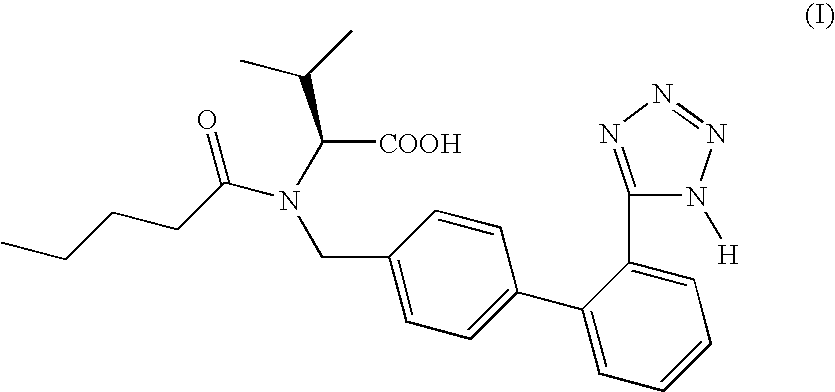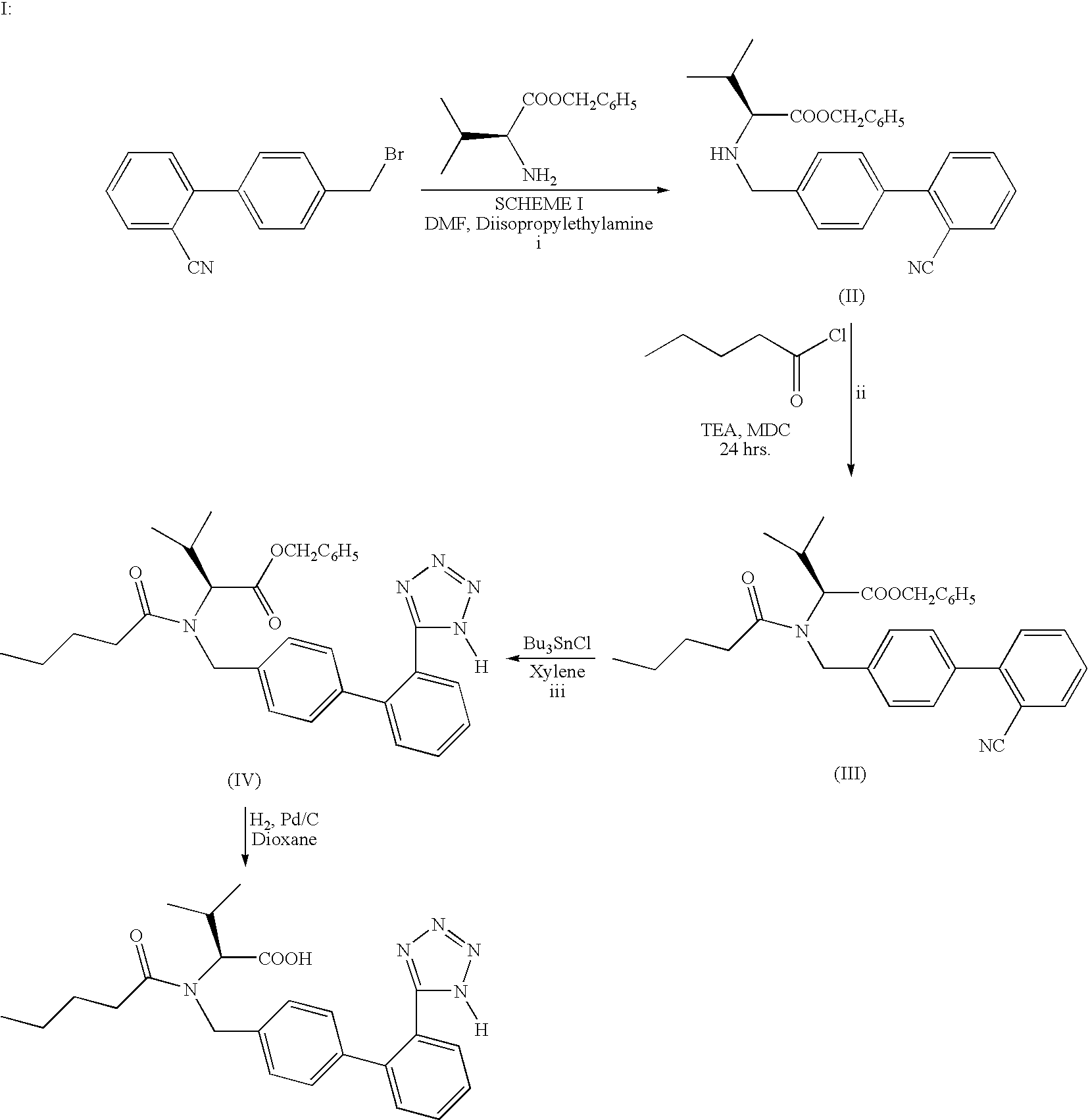Process for the preparation of valsartan and its intermediates
a technology of valsartan and intermediates, applied in the field of process for the preparation of valsartan and its intermediates, can solve the problems of long reaction time, many disadvantages, incomplete reactions,
- Summary
- Abstract
- Description
- Claims
- Application Information
AI Technical Summary
Benefits of technology
Problems solved by technology
Method used
Image
Examples
example 1
(S)-N-[(2′-cyanobiphenyl4-yl)methyl]-(L)-valine benzyl ester hydrochloride (Formula II)
[0048] 4-bromomethyl-2′-cyanobiphenyl (15 g, 0.055 mol), L-valine benzyl ester tosylate (20.9 g, 0.055 mol), potassium carbonate (21 g, 0.152 mol), and potassium iodide (0.21 g) were heated to 50-55° C. in toluene (63 mL) and water (63 mL) for 25 hours. After cooling, the two phases separated. The organic layer was water washed (2×50 mL) and acidified with hydrochloric acid to pH 1-2; upon which, (S)-N-[(2′-cyanobiphenyl-4-yl)methyl]-(L)-valine benzyl ester hydrochloride crystallized. Precipitated solids were filtered, washed with toluene and dried to give 17.9 g (75% yield) of (S)-N-[(2′-cyanobiphenyl-4-yl)methyl]-(L)-valine benzyl ester hydrochloride having a purity of 97% as measured by HPLC area percent.
example 2
(S)-N-[(2′-cyanobiphenyl-4-yl)methyl]-(L)-valine benzyl ester hydrochloride (Formula II)
[0049] 4-bromomethyl-2′-cyanobiphenyl (15 g, 0.055 mol), L-valine benzyl ester tosylate (20.9 g, 0.055 mol), potassium carbonate (21 g, 0.152 mol), and tetrabutyl ammonium bromide (0.21 g) were heated to 50-55° C. in xylene (63 mL) and water (63 mL) for 25 hours. After cooling, the two phases separated. The organic layer was water washed and acidified with hydrochloric acid to pH 1-2; upon which, (S)-N-[(2′-cyanobiphenyl-4-yl)methyl]-(L)-valine benzyl ester hydrochloride precipitated. The obtained solids were filtered, washed with toluene and dried to give 17.4 gms (73% yield) of (S)-N-[(2′-cyanobiphenyl-4-yl)methyl]-(L)-valine benzyl ester hydrochloride having a purity of 97% as measured by HPLC area percent.
example 3
(S)-N-[(2′-cyanobiphenyl-4-yl)methyl]-(L)-valine benzyl ester hydrochloride (Formula II)
[0050] 4-bromomethyl-2′-cyanobiphenyl (4.2 kg, 0.0154 Kmol), L-valine benzyl ester tosylate (5.85 kg, 0.0154 Kmol), potassium carbonate (5.88 kg, 0.0426 Kmol), tetrabutyl ammonium bromide (0.059 kg) and potassium iodide (0.059 kg) were heated to 50-55° C. in toluene (17.6 L) and water (17.6 L) for 25 hours. After cooling, the two phases separated. The organic layer was water washed (2×14 L) and acidified with hydrochloric acid to pH 1-2; upon which, the (S)-N-[(2′-cyanobiphenyl-4-yl)methyl]-(L)-valine benzyl ester hydrochloride precipitated which was filtered, washed with toluene and dried to give 6.05 kgs (90% yield) of (S)-N-[(2′-cyanobiphenyl-4-yl)methyl]-(L)-valine benzyl ester hydrochloride having a purity of 97% as measured by HPLC area percent.
PUM
| Property | Measurement | Unit |
|---|---|---|
| temperature | aaaaa | aaaaa |
| temperature | aaaaa | aaaaa |
| temperature | aaaaa | aaaaa |
Abstract
Description
Claims
Application Information
 Login to View More
Login to View More - R&D
- Intellectual Property
- Life Sciences
- Materials
- Tech Scout
- Unparalleled Data Quality
- Higher Quality Content
- 60% Fewer Hallucinations
Browse by: Latest US Patents, China's latest patents, Technical Efficacy Thesaurus, Application Domain, Technology Topic, Popular Technical Reports.
© 2025 PatSnap. All rights reserved.Legal|Privacy policy|Modern Slavery Act Transparency Statement|Sitemap|About US| Contact US: help@patsnap.com



